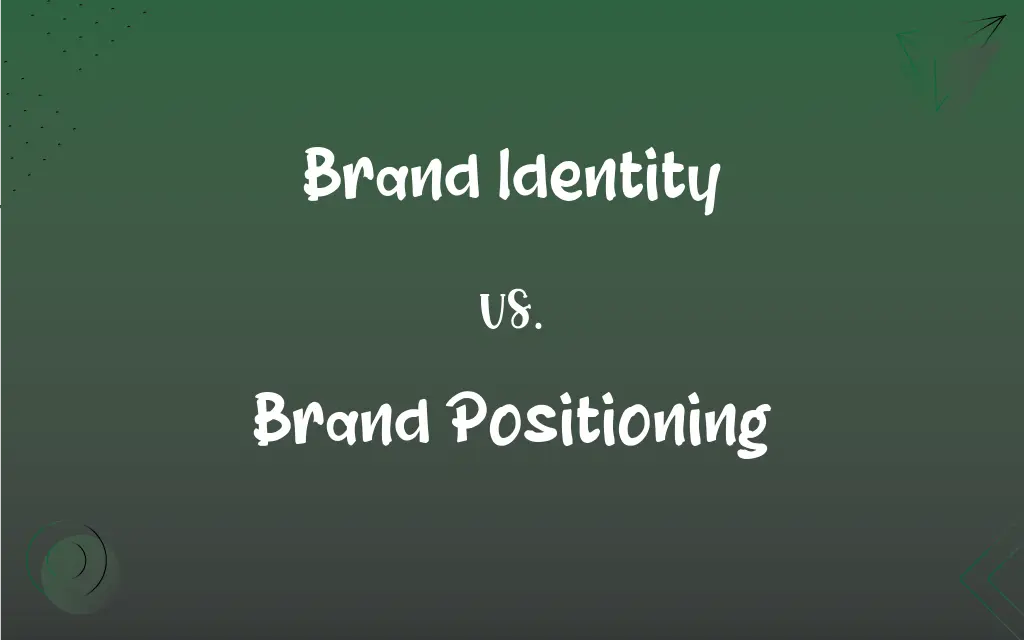Brand Identity vs. Brand Positioning: What's the Difference?
Edited by Harlon Moss || By Janet White || Published on December 20, 2023
Brand identity is the visible elements of a brand, such as color and design that distinguish it in consumers' minds. Brand positioning is the process of placing a brand in a certain market segment, emphasizing its uniqueness compared to competitors.

Key Differences
Brand identity revolves around the tangible elements that form a brand's visual and stylistic representation. It includes logo, colors, typography, and packaging, creating a distinct image in the consumer's mind. Brand positioning, however, focuses on how a brand is perceived in the context of the market. It involves identifying and targeting specific market segments, highlighting the brand's unique value propositions.
Developing a brand identity involves a creative process, where visual elements are crafted to reflect the brand's personality and values. It's about the aesthetic appeal and the message these elements convey. Brand positioning is more strategic, entailing market research and analysis to identify the brand's place in the market. It's about differentiating the brand from competitors and establishing a unique space in the consumer's mind.
The purpose of brand identity is to create a consistent and recognizable image that resonates with the target audience. It's about building a visual connection with consumers. Brand positioning aims to establish the brand's credibility and desirability in a specific market segment. It's about the perceived value and relevance of the brand to the consumers.
Brand identity may evolve as the company grows, to stay relevant and appealing to the audience. This evolution is often gradual to maintain familiarity. Brand positioning can change more dynamically in response to market shifts, competition, and consumer preferences. It's about staying competitive and relevant in the evolving market.
Brand identity communicates directly through visual cues and design, creating a first impression. It's what makes a brand recognizable. Brand positioning, however, communicates indirectly through marketing strategies and consumer experiences. It's how the brand is understood and remembered in the competitive landscape.
ADVERTISEMENT
Comparison Chart
Definition
The visual and stylistic representation of a brand
The strategic placement of a brand in the market
Key Elements
Logo, colors, typography, design
Market segmentation, unique value proposition
Primary Focus
Creating a recognizable and appealing brand image
Establishing the brand's place and value in the market
Communication Method
Direct, through visual elements
Indirect, through strategic market placement
Change Adaptation
Evolves with brand growth and trends
Adapts to market changes and competition
ADVERTISEMENT
Brand Identity and Brand Positioning Definitions
Brand Identity
The unique visual and aesthetic elements that make up a brand's public image.
Their brand identity, with its minimalist design and neutral palette, appealed to a modern, young audience.
Brand Positioning
The process of positioning your brand in the mind of your customers.
They achieved successful brand positioning by emphasizing their unique technology and superior customer service.
Brand Identity
The tangible expression of a company's brand, including its logo, typography, and colors.
The brand identity was instantly recognizable, with its bright red logo and unique font.
Brand Positioning
The marketing strategy that aims to make a brand occupy a distinct position, relative to competing brands, in the mind of the customer.
By positioning the brand as youthful and adventurous, they captured a significant share of the younger demographic.
Brand Identity
The collection of all visual elements that a company uses to portray its image to consumers.
The brand identity of the coffee shop was warm and inviting, with earthy colors and a rustic logo.
Brand Positioning
The place a brand occupies in the minds of customers and how it is distinguished from the products of competitors.
The brand positioning as the most affordable and reliable option resonated well with budget-conscious consumers.
Brand Identity
The outward expression of a brand, including its name, trademark, communications, and visual appearance.
The brand identity clearly communicated luxury and exclusivity with its elegant typeface and gold accents.
Brand Positioning
The act of designing the company's offering and image to occupy a distinct place in the mind of the target market.
Their brand positioning in the luxury segment was marked by exclusivity and high-end service.
Brand Identity
The visual aspects that form part of the overall brand image.
The brand identity was revamped to reflect a more contemporary and digital-friendly look.
Brand Positioning
The strategic effort to influence a customer's perception of a brand or product relative to competitors.
Their brand positioning focused on being the most eco-friendly choice in the market.
FAQs
How is brand positioning different from brand identity?
Brand positioning is the strategic process of defining a brand's place in the market, while brand identity is about the visual elements that represent the brand.
Why is brand identity important?
Brand identity is crucial for creating a recognizable and memorable image that resonates with the target audience.
Can a small business benefit from brand positioning?
Yes, effective brand positioning can benefit businesses of all sizes by clarifying their market niche.
How often should brand positioning be reviewed?
Brand positioning should be reviewed regularly to ensure it aligns with market changes and consumer preferences.
Is brand positioning only about competition?
While competition is a key factor, brand positioning also involves understanding consumer needs and market trends.
Does brand positioning impact marketing strategies?
Yes, brand positioning directly influences marketing strategies and messaging.
How does color influence brand identity?
Color in brand identity can evoke emotions and associations, influencing how consumers perceive the brand.
What is brand identity?
Brand identity is the visual and stylistic elements of a brand, like its logo, colors, and design, that create its image.
What does brand positioning aim to achieve?
Brand positioning aims to establish a unique space for the brand in the market and in the minds of consumers.
Can brand identity evolve over time?
Yes, brand identity can evolve to stay relevant and appealing to the target audience.
What elements are crucial for a strong brand identity?
A strong brand identity typically includes a distinctive logo, consistent color scheme, and clear typography.
What's the first step in developing a brand identity?
The first step is usually defining the brand's core values and personality.
Can brand identity be too unique or distinct?
While uniqueness is valuable, brand identity should also be relatable and relevant to the target audience.
Can brand positioning change consumer behavior?
Effective brand positioning can influence consumer preferences and purchasing decisions.
Does digital presence affect brand positioning?
Yes, a brand's digital presence, including social media and websites, is integral to its positioning strategy.
What role does a logo play in brand identity?
A logo is a central element of brand identity, serving as a recognizable symbol that represents the brand.
How does brand identity affect customer perception?
A well-crafted brand identity positively influences customer perception by creating a strong, appealing brand image.
Is brand positioning relevant in all markets?
Yes, brand positioning is relevant across different markets and industries.
What's the relationship between brand positioning and brand loyalty?
Strong brand positioning can foster brand loyalty by establishing a clear and favorable brand image.
How do typography and design affect brand identity?
Typography and design play a key role in conveying the brand's personality and values visually.
About Author
Written by
Janet WhiteJanet White has been an esteemed writer and blogger for Difference Wiki. Holding a Master's degree in Science and Medical Journalism from the prestigious Boston University, she has consistently demonstrated her expertise and passion for her field. When she's not immersed in her work, Janet relishes her time exercising, delving into a good book, and cherishing moments with friends and family.
Edited by
Harlon MossHarlon is a seasoned quality moderator and accomplished content writer for Difference Wiki. An alumnus of the prestigious University of California, he earned his degree in Computer Science. Leveraging his academic background, Harlon brings a meticulous and informed perspective to his work, ensuring content accuracy and excellence.







































































